SPSS OMS (short for Output Management System) can convert your output to SPSS datasets. As we'll demonstrate in a minute, this can save you huge amounts of time, effort and frustration.
We recommend you follow along by downloading and opening course_evaluation.sav, part of which is shown below.
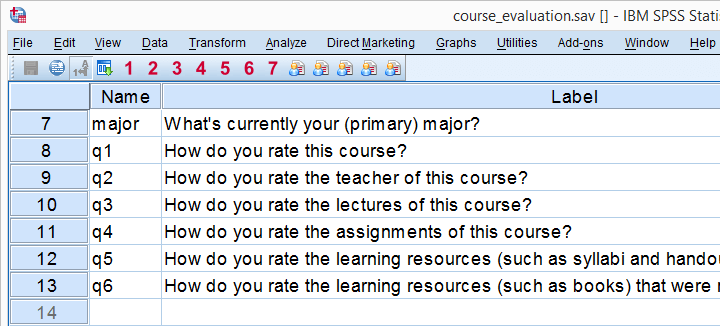
Today’s Challenge
Some client wants to see charts holding correlations of q2 through q6 with q1 for each study major (psychology, anthropology) separately as shown here. This request -not unusual in market research- typically makes novice SPSS users
- panic,
- run the correlations in SPSS,
- copy/paste everything into Excel sheets and
- generate the charts one by one.
Unknown to many SPSS users, there's a much -much- faster way for getting this job done. It's called OMS.
Step 1: Split File
We'd normally always start with a routine data inspection but that's been done for you in this case. Now, a fast way for just running the desired correlations is by using SPLIT FILE. The syntax below shows how to do so.
sort cases by major.
split file by major.
*2. Show only variable labels in output table.
set tvars labels.
*3. Create correlation table.
correlations q2 to q6 with q1.
Result

Step 2: OMS Control Panel
Right, we created our correlations but they're in our output viewer window. We can't create charts from tables in our output window so we need this correlation table in data view instead.
We'll do just that by navigating to  which is shown below.
which is shown below.
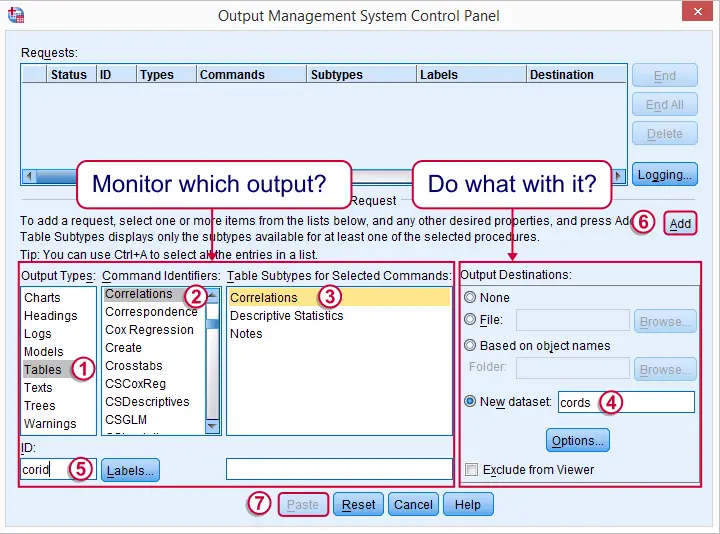
We'll follow the steps in the screenshot: we select our correlation table in the left half of the dialog.
 It's a best practice to always specify an here. In this case, “corid” is short for “correlation id”
It's a best practice to always specify an here. In this case, “corid” is short for “correlation id”
 We then select in the right half of the dialog. “cords” is short for “correlation dataset”.
We then select in the right half of the dialog. “cords” is short for “correlation dataset”.
Clicking triggers a popup dialog confirming our OMS request. Just ignore it.
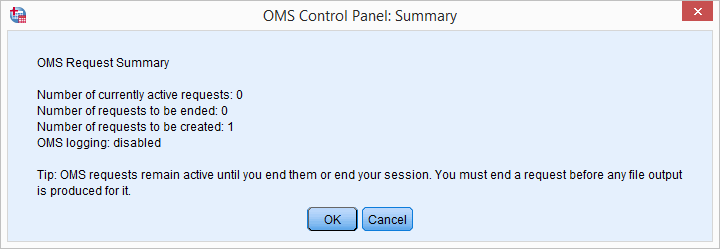
Clicking then generates the first block of the syntax below. We then (manually) added two lines to it.
SPSS OMS Syntax Example
DATASET DECLARE cords.
OMS
/SELECT TABLES
/IF COMMANDS=['Correlations']
SUBTYPES=['Correlations']
/DESTINATION FORMAT=SAV
NUMBERED=TableNumber_
OUTFILE='cords'
/TAG='corid'.
*2. (Manually added) correlations command.
correlations q2 to q6 with q1.
*3. (Manually added) omsend command.
omsend tag = ['corid'].
SPSS OMS Syntax - How Does It Work?
The next figure explains how our syntax basically works. In a nutshell,
- the OMS command has SPSS monitor selected output following it so
- our correlation table is captured by the OMS.
- OMSEND then stops SPSS from monitoring output and create our desired correlations dataset.
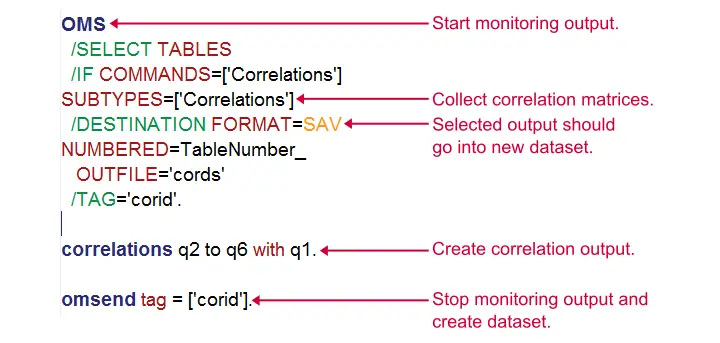
Result

We now have our correlation matrix in an SPSS dataset, which allows us to run charts on it. We'll prepare these data a tiny bit before doing so with the syntax below.
dataset activate cords.
*2. Delete all rows that don't hold correlations.
select if char.index(var3,'Pearson') > 0.
execute.
*3. Split file by var1 (= study major).
sort cases by var1 howdoyouratethiscourse.
split file by var1.
Step 3: Creating Our Charts
We'll now create our desired charts by following the figure below. Since we're using SPLIT FILE, we need only one single command for creating all charts at once.
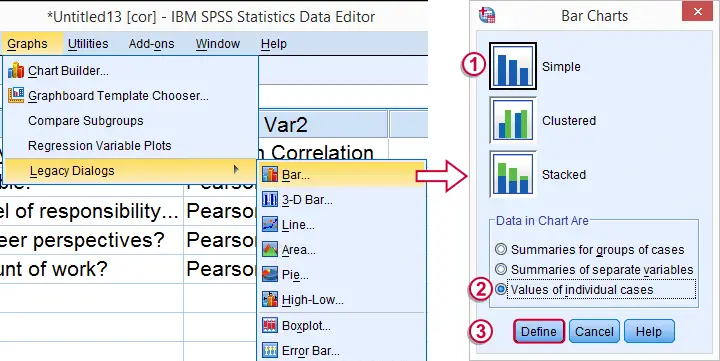
 In the second dialog (below), choose a nice main title for your charts. We decided upon “Correlations with Course Rating”.
In the second dialog (below), choose a nice main title for your charts. We decided upon “Correlations with Course Rating”.
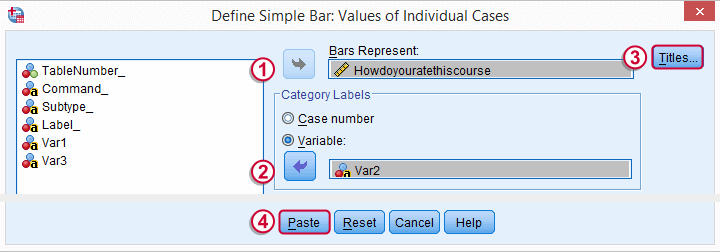
Following these steps results in the syntax below. Running it generates all desired charts.
SPSS Bar Chart Syntax Example
GRAPH /BAR(SIMPLE)=VALUE(Howdoyouratethiscourse) BY Var2/title 'Correlations with Course Rating'.
Step 4: Prettifying our Charts
We now have the charts we wanted. A nice trick to make them look great with little effort is creating a chart template for them.
We double click just one of our charts and transpose it as shown below.
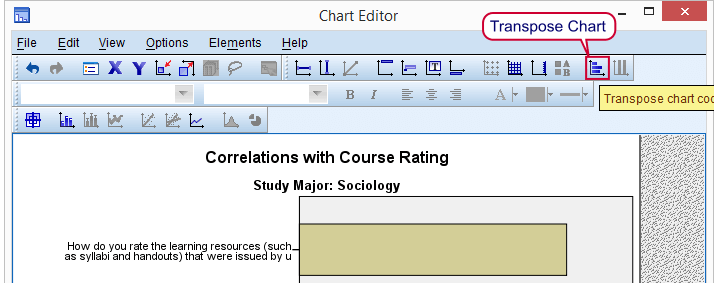
Next, we change the colors, fonts, layout, everything in our first chart until it looks nice. Then navigate to  as explained in SPSS chart templates.
as explained in SPSS chart templates.
SPSS - Creating Pretty Charts
Finally, we activate the chart template we just created (step 3 below, first set path to .sgt file correctly). We then rerun the GRAPH command we pasted and ran previously and - there you go - five pretty charts in a split second.
If you ever get a similar request for different data, you can now rerun your syntax on it and you'll be done in seconds. As a bonus, you can probably (edit and) reuse your chart template other bar charts too.
Final Syntax Using Chart Template
variable labels var1 "Study Major".
*2. Suppress excessive decimal places.
formats howdoyouratethiscourse (f1).
*3. Activate newly created chart template (set path appropriately).
set ctemplate 'my-project-folder\my-template.sgt'.
*4. Rerun all graphs at once with chart template.
GRAPH /BAR(SIMPLE)=VALUE(Howdoyouratethiscourse) BY Var2/title 'Correlations with Course Rating'.
*5. Switch off chart template for any future graphs.
set ctemplate none.
Final Result
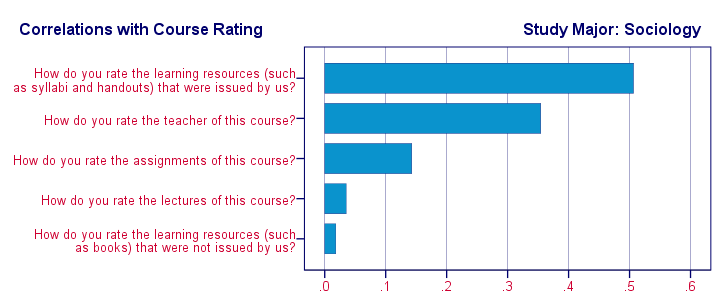
Final Notes
SPSS OMS can be a tremendous time saver. Today's tutorial redirected a single correlation table to an SPSS dataset but you can very easily create a single dataset holding output from 1,000 or more output tables. In fact, we did just that in the simulation studies we presented when explaining the basic idea behind ANOVA, regression and the chi-square test. In these studies we basically
- used one OMS command for capturing all ANOVA tables,
- ran ANOVA on 1,000 random samples from a population data file,
- ran OMSEND for creating a dataset with 1,000 F-values and
- created a histogram for visualizing our sampling distribution.
As we see, SPSS OMS opens up a lot of possibilities. We hope it'll help you save time and effort as well!
 SPSS TUTORIALS
SPSS TUTORIALS
THIS TUTORIAL HAS 10 COMMENTS:
By Jon Peck on April 25th, 2016
1. OMS is a great tool for using output as input as you have demonstrated. I this case, though, you say that you can't generate charts from output tables. But you can! Activate the table, make a selection, right click, and choose Create Graph.
2. Please remove the useless and time wasting EXE
By Ruben Geert van den Berg on April 25th, 2016
Thanks for your comment, Jon!
1. You're right, I forgot about that option. However, that can't be done by syntax, right? Perhaps the current approach may be easier with a chart template applied and SPLIT FILE in effect for creating separate charts for separate groups.
2. I'm well aware that the EXECUTE is redundant. However, some readers get confused when running SELECT IF ... and nothing seems to happen, which is why I chose to add it anyway.
I sometimes use "rendundant" EXECUTE commands in my daily work too for being able to inspect the result of transformations right away. In my experience, the time loss is only noticeable when processing large data files.
By Jon Peck on April 25th, 2016
Yes, charting from tables is interactive only as it requires selection in the table. Most users don't know about it, but it can be handy sometimes. As for EXECUTE, the default in the gui is to generate it to avoid confusion, but users, especially coming from SAS, think it's necessary and then complain about performance on large datasets.
By Melkamu Hailu on June 12th, 2017
Thanks for your full information for the future please send to me more information in SPSS documents by my email address.
By Atul Singh Chauhan on August 17th, 2018
Thank. I have a query. Searched a lot. Can we use output value (Examine -> Percentile) to compute into another value (for each percentile. The percentile value used is Tukey's Hinges). Which would be used for further